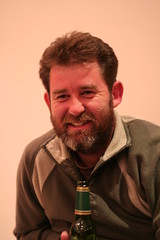Arrival, FOSS4G2008
Posted in FOSS4G 2008, Locality and Space on September 28th, 2008 at 01:00:55Have arrived in Cape Town in preparation for FOSS4G. And the most important part of the trip — the drinking of the beers — is already in full force.
I’m staying in the Fountains Hotel; apparently a good choice, given the number of random FOSS4G passerby we’ve had so far.
18 hours of flying is a long time, but didn’t go poorly, though I am lacking any clothes until Monday afternoon (so I’ll be kind of stinky for my workshop with Josh on GeoDjango on Monday). Made it to the hotel, then headed out to Dinner at Cape To Cuba. Was good environment and tasty, for not a bad price. We then went back to the Fountains Hotel and had a couple drinks at the hotel bar.
I’ve uploaded pictures — they’re tagged by day and foss4g2008, so you should be able to see daily shots as I continue to upload them. (I’ve also got a FOSS4G 2008 set.) Today we’re doing a trip up Table Mountain — taking the cable car — leaving from Fountains Hotel around 10AM (breakfast at 9:15).
PSA: If you’re at all interested in GeoDjango, and have more than a passing knowledge of Python, I highly recommend coming to our GeoDjango workshop (and bringing a laptop). It’s gonna be great.
PSA2: If you’re staying at Fountains, and don’t want to go down to the desk to get an internet voucher, you can still ssh. Just join the wireless network, and ‘ssh $ipaddress’. (If you don’t know your IP address, you can look it up by using ‘dig @72.232.176.58 yourdomain.example.com’.) If you need to get to the web, you can add “-D 4000” to your ssh command — ‘ssh -D 4000 crschmidt.net’ — to set up a SOCKS proxy. Then, in Firefox Preferences -> Advanced -> Network -> Connection, do manual Proxy configuration, and enter ‘localhost’, ‘4000’ as a “SOCKS Host”.
